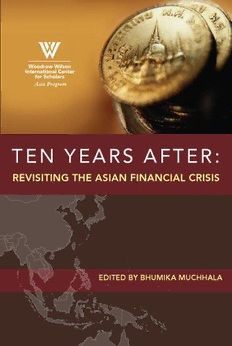
Ten Years After: Revisiting the Asian Financial Crisis: Essays PDF
70 Pages·1.195 MB·English
Most books are stored in the elastic cloud where traffic is expensive. For this reason, we have a limit on daily download.
Preview Ten Years After: Revisiting the Asian Financial Crisis: Essays
Description:
The Asian financial crisis of 1997-98 is now seen as one of the most significant economic events in recent world history. The crisis began in early July 1997, when the Thai baht was floated, and spread into a virulent contagion—leaping from Thailand to South Korea, Indonesia, the Philippines, and Malaysia. It led to severe currency depreciations and an economic recession that threatened to erase decades of economic progress for the affected East and Southeast Asian nations.The sequence of events triggered a self-reinforcing spiral of panic, which many analysts argue was premised on a confluence of the inherent volatility of financial globalization and the weak domestic financial systems in East Asia. Financial liberalization in the region led to surges in capital flows to domestic banks and firms, which expanded bank lending, ultimately resulting in a rapid accumulation of foreign debt that exceeded the value of foreign exchange reserves. As international speculation on dwindling foreign reserves mounted, the regional currencies came under attack.
See more
The list of books you might like
Most books are stored in the elastic cloud where traffic is expensive. For this reason, we have a limit on daily download.
